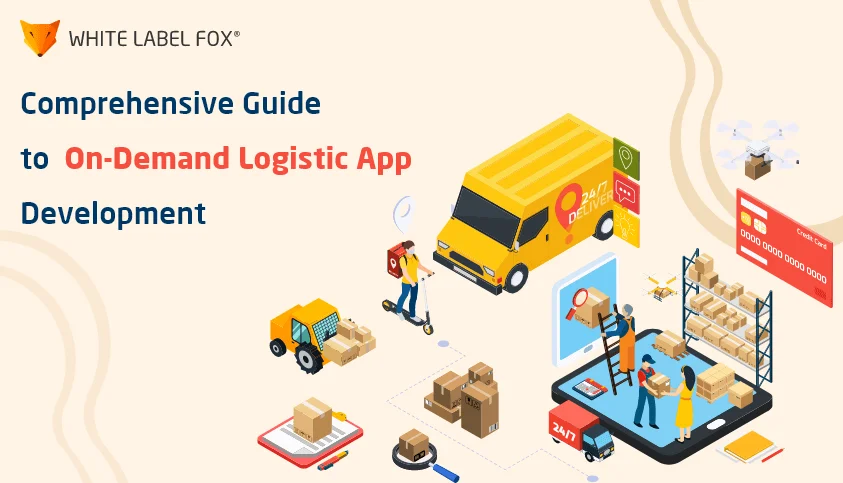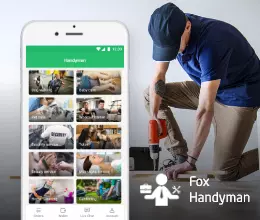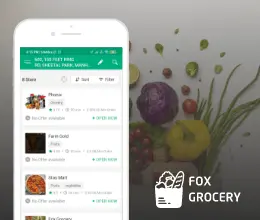Comprehensive Guide to On-Demand Logistic App Development
The logistics and transportation services demand is growing, giving rise to on-demand logistic app development. The advent of this logistics application has revolutionized the industry. These feature-rich apps have changed how goods and services are transported, making it easier for customers and businesses to connect with delivery services, carriers, and couriers.
This guide can be a savior if you’re thinking of on-demand app development. From concept to deployment, this comprehensive guide to on-demand logistic app development helps you dive deeply into the topic.
On-demand Logistic App Market: Have a Deep Dive into it!
The logistics software market is valued at around 10.1 billion in 2022. This market is projected to grow from 10.9 Billion to 20.7 Billion by 2032. The logistic software market will exhibit an 8.31% growth between 2023 and 2032. Emerging digital technology is a key driver for market growth.
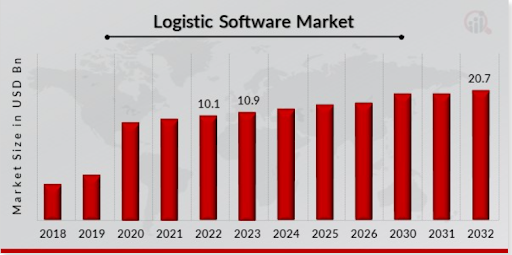
Source: (Market Research Future)
Logistic software provides lots of benefits, including saving time and money. The on-demand logistics market service type is segmented into warehousing, transportation, and value-added services. When it comes to application, it’s fragmented into healthcare, manufacturing, documents & letters, and e-commerce & retail.
The market is estimated to reach around $77.62 billion by 2030, with a 17.54% CAGR between 2021 and 2030. The growth is due to the increasing use of on-demand solutions and the growing demand for quick delivery.
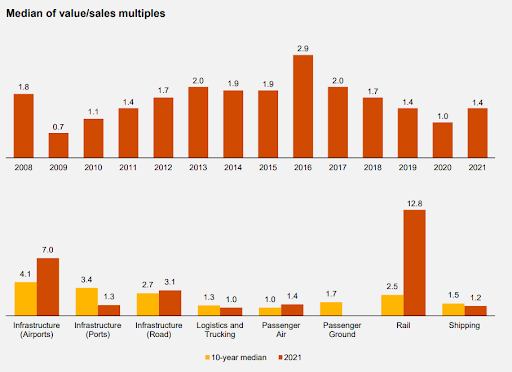 Source: (PwC)
Source: (PwC)
Industry and trucking holds the highest market share. The eCommerce market is projected to reach $36 Tn by 2030. With the increasing online shopping preference, there is a rise in efficient logistics solutions for last-mile delivery, order fulfillment, and inventory management.
A user-centric on-demand logistic app enables businesses to enhance visibility, optimize their supply chain operations, and meet customers’ growing demands. The AI & ML powered apps decrease the logistic cost by almost 20% with error-free resource optimization.
Having insight into growing market statistics helps you understand the importance of on-demand logistic app development. Let’s check what it is, on-demand logistic app development type, and more.
What is On-Demand Logistic App Development?
On-demand logistic app development refers to creating mobile applications that facilitate and optimize various logistics and transportation industry aspects. These applications are designed to connect users, businesses, and logistics service providers in a digital ecosystem, offering convenient and efficient solutions for tasks such as ordering, tracking, and managing shipments, deliveries, and other logistics-related processes.
Type of On-Demand Logistic App Development
There are different types of on-demand app development you can choose to invest in, explore the below list to know more:
Freight and Cargo Booking Apps
These apps are designed to streamline the booking and tracking of freight and cargo shipments, catering to businesses transporting goods over longer distances.
Freight and cargo booking apps often include features for route optimization, real-time tracking, and documentation management. For example, Uber Freight and other freight management platforms.
Last-Mile Delivery Apps
It’s the final leg of the delivery process, often considered the most challenging and costly. Apps in this category focus on optimizing last-mile logistics for e-commerce and retail businesses. You can invest in delivery apps with all the features like delivery scheduling, route optimization, etc.
Warehouse Management Apps
These apps are developed to streamline and optimize warehouse operations, including order fulfillment, inventory management, and tracking of goods within the warehouse. For example, apps that business owners use with large-scale warehouse operations.
Delivery & Courier Application
These apps focus on facilitating the delivery of packages, parcels, and documents from one location to another. Users can use delivery apps to place delivery requests, get real-time status, make payments, and receive notifications upon delivery completion. For example, Postmates, DoorDash, and courier services are provided by major logistics companies.
Supply Chain Management Apps
This type of app provides end-to-end visibility and control over the complete supply chain, from production to distribution. Functilionaties, including order placing, real-time tracking, demand forecasting, etc., are integrated into supply chain management apps.
Vehicle Tracking & Fleet Management Apps
These apps focus on tracking and managing a fleet of vehicles, optimizing routes, monitoring fuel consumption, and ensuring timely maintenance. Vehicle tracking and fleet management apps improve operational efficiency and decrease costs.
Comprehensive Guide to On-Demand Logistic App Development
In the fast-paced logistics world, efficiency is paramount. The rise of on-demand logistic apps has revolutionized how goods are transported, managed, and delivered. Explore the guide to on-demand logistic app development:
Market Research
Statista report shows that online surveys in 2022 were the most preferred traditional quantitative methodologies in the research sector worldwide. More than 85% of respondents state that they use online surveys as survey methods. However, 9% of respondents said that they used online surveys occasionally.
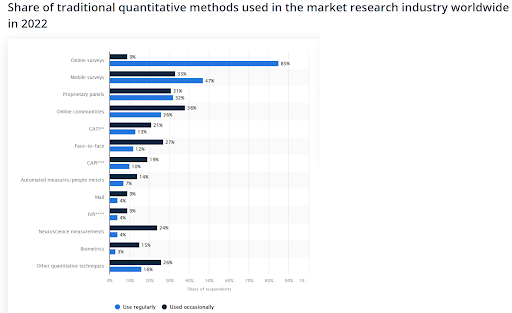 Source: (Statista)
Source: (Statista)
Before diving into development, conduct thorough market research. Identify your target audience, analyze competitors, and understand all the challenges and opportunities in the logistics industry. This knowledge will guide your on-demand logistic app’s features and functionalities.
Define Your Value Proposition
Clearly define what sets your on-demand logistic app apart from others. Whether it’s real-time tracking, advanced analytics, or seamless communication, a compelling value proposition will attract users and stakeholders.
Defining Your App’s Purpose
Grand View Research indicates that the adoption of logistics management software is expected to grow at a 14.7% CAGR between 2023 and 2030.
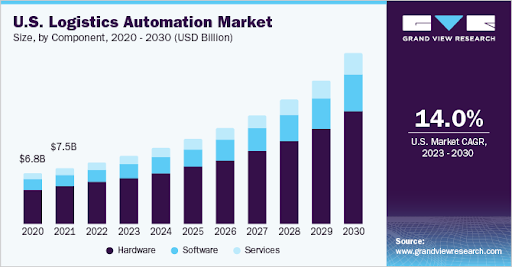 Source: (Grand View Research)
Source: (Grand View Research)
Clearly define the purpose of your logistics app. Whether it’s streamlining supply chain operations, enhancing visibility, or optimizing route planning, a well-defined goal will guide the development process.
Choose the Right Technology Stack
Selecting the technology stack is crucial for the success of your app. Consider scalability, security, and compatibility with various devices and platforms.
Gartner predicts that by 2023, approximately 50% of global leading enterprises will rely on at least one public cloud provider for their logistics applications. Integration of technologies for logistic app development, including GPS for real-time tracking, cloud services for data storage, robust backend frameworks, and Artificial Intelligence (AI) for predictive analytics, is vital for staying competitive.
Features and Functionality
Design your app with essential features that address the logistics industry’s needs and contribute to the overall success of logistics apps. Key features include:
Real-time Tracking: Provide live updates on the location and status of shipments.
Route Optimization: Optimize routes to save time and fuel costs.
Electronic Proof of Delivery (ePOD): Enable digital signatures and documentation.
Inventory Management: It helps to track and manage inventory in real time.
Notifications: Inform users about order status, delays, and other relevant updates.
Payment Integration: Facilitate secure and seamless transactions.
Analytics and Reporting: Provide insights into performance, efficiency, and cost-effectiveness.
There are a lot of features and functionalities that you can consider during on-demand logistic app development. It includes all the core features to address the primary needs and requirements of the users.
User-friendly Interface
More than 84% of users say a seamless experience across all devices is important. Hence, create an intuitive and user-friendly interface to enhance the user experience. A well-designed app increases user engagement and satisfaction, leading to higher adoption rates.
Security Measures
The IBM Report highlights that the average total cost of a data breach is $4.24 million. Prioritize security measures to protect sensitive data. Adhere to compliance standards, including GDPR and other regional regulations governing data protection in the logistics sector.
Security is paramount in logistic app development, given the sensitive nature of the data involved. Implement security measures to protect payment details, sensitive business data, user details, etc.
Scalability for Future Growth
The logistics automation market will grow from 32.7 billion to 51.2 billion between 2023 & 2028, at a 9.3% CAGR during the forecast period. The digital transformation across the industry will drive the market. Scalability ensures that your app remains effective as your user base expands.
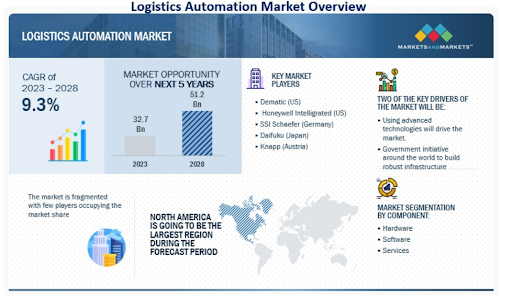 Source: (MarketsandMarkets)
Source: (MarketsandMarkets)
Build your app with scalability in mind to accommodate future growth. As your user base expands, ensure your app can handle increased data traffic and user demands without compromising performance.
Compliance and Regulations
Adhere to local and international regulations governing the logistics industry. Ensure your logistic app complies with data protection laws, transportation regulations, and other relevant standards.
Testing
A study found that 62% of users uninstall an app if they encounter bugs or glitches. Hence, conduct rigorous testing to identify and eliminate bugs, ensuring a seamless user experience. User acceptance testing is crucial to validate that your app meets user expectations.
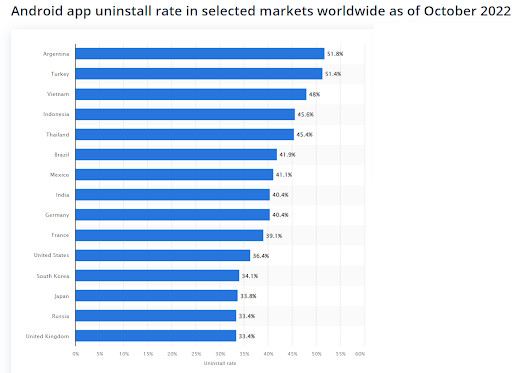 Source: (Statista)
Source: (Statista)
Thoroughly test your on-demand app to identify and fix bugs, security vulnerabilities, and performance issues. Consider user acceptance testing to ensure that the logistics app meets the expectations of your target audience.
Launch and Marketing Strategy
Statista report shows that apps are projected to generate approximately $935 billion in revenue by the end of 2023. Plan a strategic launch for your on-demand logistic app. Implement promotional marketing strategies to create awareness and attract users. Use digital marketing, social media, and partnerships to maximize your app’s visibility and acquisition.
Get Your On-Demand Logistic App Developed Today!
Embarking on the journey of on-demand logistic app development demands strategic planning, technological prowess, and an unwavering commitment to addressing the evolving requirements of the logistics industry. This guide navigates the essential steps, from market research and technology selection to user-friendly design and scalability.
With the global logistics market expected to gain staggering figures, the demand for innovative solutions is more apparent than ever. In this transformative landscape, your choice of development partner is pivotal. White Label Fox stands as a reliable ally on your journey.
White Label Fox specializes in on-demand solutions, including logistics app development, offering expertise, innovation, and a commitment to delivering white-label solutions that align with your business goals. Our experience in creating robust, scalable, and user-centric applications positions us as a valuable partner in propelling your logistics venture to new heights.
Together, we can redefine the future of logistics and revolutionize how goods move globally.
For inquiries and to kickstart your on-demand logistic app development, contact us at [email protected]. Let’s turn your vision into reality and shape the future of logistics together.
OUR PRODUCTS


